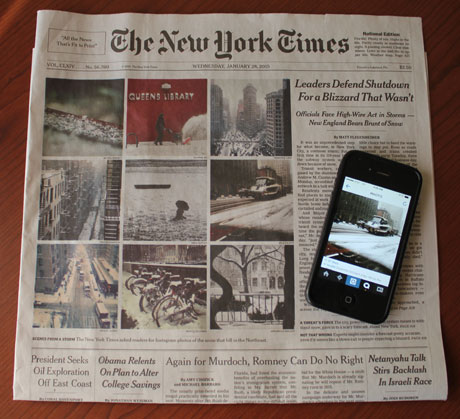Follow-up story: Instagrammer: ‘I am very happy my photo was selected’
It was an exciting moment for user-generated content. The New York Times featured nine Instagram photos on the front page of its Wednesday edition.As far as I can tell, it was the first time audience-submitted Instagram photos landed on the front page of the printed edition. Poynter reached out to The New York Times for comment, but did not receive a response by time of publication.
This wasn’t the first occasion that the Times featured an Instagram shot on its front page. In March 2013, the paper published an Instagram portrait of Alex Rodriguez. Sports portraitist Nick Laham shot the photo, which was licensed by Getty.
Overall, I was thrilled to see the placement. Prior to joining Poynter, I was the editor of CNN iReport, the network’s citizen journalism platform. Throughout my tenure, I often made the case that user-generated content could stand alongside professional reporting – given the necessary context and verification, of course.
The Times’ Wednesday layout, which placed audience snow images alongside the paper’s own reporting, was an excellent example of how to properly incorporate UGC. The Times invited their audience to share images earlier in the week. (I didn’t note this in an earlier version of this story. Thanks to everyone who pointed it out.)
Unfortunately, there were a few missteps in the front-page placement. For starters, they should have put users’ Instagram handles in the photo credits, at least in the digital version. To be fair, the Times does get points for crediting their readers by full name.
More egregiously, though, the paper did not inform users that their photos earned front-page status. Based on the comments on their Instagram posts, most of the photographers found out thanks to the kindness of friends and strangers.
Jeca Taudte, one of the Instagrammers featured, said the Times didn’t contact her prior to publishing her photo. “Another gracious Instagrammer [commented] on my photo, which alerted me to the fact that me submission had been selected for the online slideshow,” she said. It wasn’t until a Facebook friend posted a photo of the paper that Taude realized that her shot made it on the Times’ front page.

Taudte later passed on the favor, notifying Terrence Liew, Betina Schmitt and Travis Chantar via Instagram that their photos were also among the nine chosen images.
Wouldn’t you want to know in advance if your photo was going to be on the front page of The New York Times? Taudte said she was “very much” excited when she heard the news.
Audience development – including how to approach UGC seriously – was one of the main areas of focus in The New York Times Innovation Report, which created waves in the journalism world after it was leaked last May.
“Our readers are perhaps our greatest untapped resource. Deepening our connection with them both online and offline is critical in a world where content so often reaches its broadest audience on the backs of other readers. And many readers have come to expect a two-way relationship with us, so they can engage with our journalism and our journalists. This means the newsroom as a whole must take the reins in pursuing user-generated content, events and other forms of engagement in a way that reflects our standards and values.”
An important part of that two-way relationship includes informing users when you run their content.
“Closing the loop” has long been a mantra for the CNN iReport team. Whenever we quoted an iReporter in an article, featured someone’s photo in a gallery, or posted a user’s video on our Instagram feed, we would always make a point to let that person know. When possible, we’d also link to their profile on social networks.
I’m not claiming iReport is perfect, but those simple emails or phone calls went a long way towards building relationships with our community and ensuring that users would continue to contribute valuable content.
The ethics of using user-generated content are constantly transforming and there’s a healthy debate within the industry. Do you pay contributors? Ask for permission first? What happens if someone is in a dangerous situation? It’s a complicated and fascinating discussion.
UGC rules often need to be evaluated on a case-by-case basis. That said, I believe that there are two basic things all media organizations can and should do: Properly credit user-submitted photos and videos and let people know when and where their content is being featured. Those are easy and effective ways to build a relationship with your audience.
The Times got one of those things right. Here’s hoping they fully follow their own advice next time.
Correction: An earlier version of this story spelled reins incorrectly. It has been corrected.
Follow-up story: Instagrammer: ‘I am very happy my photo was selected’
Related: News University course: Copyright Law and Fair Use for Journalists









Comments